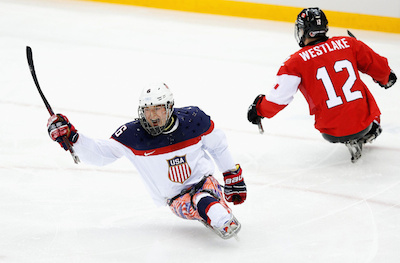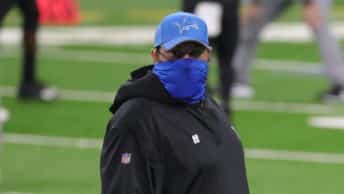 I have a quiz for you. Ready? Identify the following athletes: Mitch McKee, Tyler Carron, Nikko Landeros, Jen Lee, Andy Yohe, Steve Cash. Brady Roybal, Declair Farmer, and Alexi Salamoni.
I have a quiz for you. Ready? Identify the following athletes: Mitch McKee, Tyler Carron, Nikko Landeros, Jen Lee, Andy Yohe, Steve Cash. Brady Roybal, Declair Farmer, and Alexi Salamoni.
You would impress me if you could correctly identify even one. Two weeks ago, the names meant nothing to me, and I consider myself a fairly knowledgeable sports fan. But what these individuals have accomplished in their sport is so inspiring and so heartwarming that it makes one appreciate the good that can be found in sports, despite the far too many spoiled, self-centered professional athletes who have given sports such a negative image.
Take Minnesotan Mitch McKee. Last year, when he was an eighth grader, he learned that his father had terminal cancer. The doctors gave him perhaps a year, maybe less. Mitch wanted to do something special for his dad that would “kind of flush it all away and kind of have him forget about it for that moment and just be happy.”
So one day, Mitch decided that when he entered high school the following year, he would try to win a state wrestling championship for his dad. He went to the gym every morning at 6 and lifted weights. Once high school began, he practiced every day, and when practice was officially over, he would find others to practice some more. As the wrestling season progressed, Mitch improved rapidly. By the time the state tournament came around, his record made him a qualifier.
At the tournament he won his first match. And then he won again. He made his way through each round, and eventually he found himself in the championship match. With his dad watching from the stands, Mitch McKee pinned his opponent and fulfilled a goal he had set months before. After the referee raised his hand in victory, Mitch ran into the stands, and he and his dad held each other for a very long time.
Later, when the press asked him about his accomplishment, he said, “He might not be here next year, so I knew this was the year to do it.” By the way, the young man who lost to Mitch also went into the stands, hugged Mitch’s dad, and said, “Stay strong.” May we all be blessed with such classy children.
Now the rest of the athletes on my list are connected in two ways. Let me share the first way.
Tyler Carron and Nikko Landeros had just left a high school dance when, during an intense snow storm, the car they were driving in got a flat tire. While the two of them were outside attempting to change the tire, one of their own classmates, driving her own car at nearly fifty miles an hour, lost control and hit the boys. The impact was so great that both of them lost their legs.
Jen Lee was in the military, and whenever he was on leave back in the United States, he loved to ride his motorcycle. One day, a driver of a car apparently didn’t see him, and hit Jen so hard that one of Jen’s legs was torn off.
When Andy Yohe was in high school, he and a couple of his friends loved the rush of hopping on freight cars of a train as it slowly passed near their hometown. One day, Andy misjudged the speed of a train, and as he jumped off one of the cars, the air beneath it literally sucked him under. He lost one and half legs.
As a little boy, Steve Cash developed cancer in his left leg. The doctors were forced to remove a large section of that leg from the knee all the way to the ankle. The foot was attached to where the knee had been and became his “new” knee.
Brady Roybal was born without legs, and Declair Farmer had his legs amputated shortly after he was born.
Alexi Salamoni’s mother was a victim of the Chernobyl fallout, and after she gave birth to Alexi, she placed him in a state orphanage. He had significant nerve damage, and when he was three, the Russian doctors amputated both his legs just below the knee. But Alexi did have some luck; an American couple adopted him and raised him as their own.
Of course, the obvious connection is that they are single or double amputees. The other connection is that they are eight of the eighteen members of the United States Paralympic Sled Hockey Team.
In sled hockey, players strap themselves into a molded plastic seat which is attached to a metal frame. The frame can be long enough to accommodate a player who may have one or both legs.* Welded beneath the frame are two skate blades approximately one two two inches apart. At the front end of the frame is a curved metal piece to provide stability. Each player has two hockey sticks that are usually less than three feet long. The sticks have metal picks at the end. The players propel themselves across the ice by driving the ends of the sticks into the ice and pulling with their arms. As in regular hockey, each player wears a helmet, gloves and protective gear. The teams play on standard-sized rinks, and each period is twenty minutes in length.
Earlier this month the United States team won its second consecutive Paralympics gold medal in Sochi, defeating the Russian team 1-0. Jeff Sauer, the U.S. coach, reflecting on the “dark places” his men have come from, proudly summarizes their character: “There is no ‘woe-is-me’ attitude.”
While some people bemoan their fate and wallow in self-pity, these young men have dedicated themselves into being the best in the world at what they do. And, like Mitch McKee, they are beautiful examples of why sports matter.
* The only physical requirement for a sled hockey player is an inability to play regular hockey.








